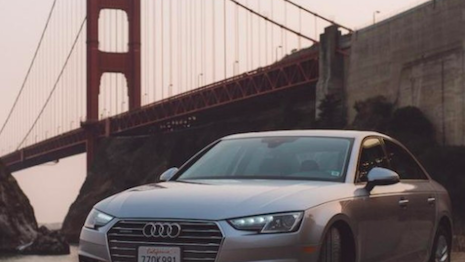Luxury carmakers were responsible for 30 percent of all global digital advertising spend within the automotive sector, as marques look to consumer data to better target affluent audiences.
According to a new report from global data company Eyeota, auto advertisers spent more than half of their 2018 budgets on segmenting consumers by demographics. Luxury automotive data spending peaked in the first and fourth quarters of the year.
“Luxury auto brands are developing demographically-focused audience targeting campaigns,” said Elissa Reiling, vice president of marketing at Eyeota, New York. “It’s important that those brands understand who their target consumers are, beyond a one-dimensional approach of high-net-worth individuals.”
Driving segments
In the automotive industry as a whole, 53 percent of data spend in 2018 was devoted to demographic segments.
Demographics include categories as broad as age, educational level and gender, as well as more nuanced identifiers such as language, generation, net worth and property type, among others.

Auto brands segment consumers on demographics, such as age and income. Image credit: Mercedes-Benz
Thirty-six percent was spent on intent or interest segments, and 11 percent was dedicated to the owner/purchase segment. Spending on interest and intent segments gradually grew during 2018.
Intent reaches consumers who have demonstrated an intent to buy through actions such as product searches and comparisons. Interest segments consumers by activities such as reading blog posts, topic-specific sites and news articles.
The owner/purchased segment is defined by those who purchased particular brands or products within a certain time frame.
Compared to the sector as a whole, luxury automakers invested more on demographic spending, 66 percent to 53 percent. Four percent of this includes employment data specifically.
Owner/purchased categorizations were also more valuable for luxury brands, which spent 3 percent more on those segments than the automotive industry average.
Among luxury automakers, spend on the intent segment drops from an average of 21 percent to 8 percent.
The most utilized audience segments by premium car brands include socioeconomic profiles, financial status, automotive owners and brand owners. Lifestyle segments, such as travelers or technology enthusiasts, can help luxury brands craft more personalized advertising as well.

American marketers spend more on sociodemographic data. Image credit: Silvercar
For all auto advertisers, spending on sociodemographic categories is most pervasive in the U.S., where it accounts for 31.8 percent of spend compared to less than 10 percent in the U.K. and Germany.
Globally, luxury automakers were responsible for 35 percent of data spending in the first and fourth quarters of 2018, with spending dipping to less than 20 percent in the third quarter. Many premium brands, including Audi and Lexus, released holiday campaigns as U.S. auto sales peaked in December.
Multicultural marketing
Less than 10 percent of global data budgets in 2018 were spent on multicultural audiences. These audience segments include consumers who are immigrants or speak multiple languages at home.
Despite the limited investment in this data, luxury brands often share ad spots that have universal appeal and feature diverse consumers.
For instance, the 19th edition of the Lexus “December to Remember” campaign focused on the memories families can make together after they add a new vehicle to their households.
Although the special moments are universal, Lexus also cast multicultural families in the spots to make them more relatable to wide audiences. For instance, a Latinx family celebrates a quinceañera and a black family is shown driving their son to college in an ES (see story).
Similarly, BMW reflected on the global importance of family and community through a film campaign released to coincide with the Islamic celebration of Ramadan.
Shared by BMW Middle East, “Two Brothers” is a multigenerational story about family and forgiveness. While the setting is meant to connect with Muslim drivers, the campaign remains relatable for a wider reach (see story).
“Part of the industry-wide reason why multicultural marketing does not consume a larger share of digital ad spend is the lack of scalable multicultural digital inventory,” Eyeota’s Ms. Reiling said. “However, audience segments via programmatic platforms are solving that issue by making it possible to target multicultural users on nearly all other sites.”
{"ct":"17KQpCf530OE9\/3A8DPBr1N6NMTbAhd1d2hS1ordyrUurL\/j3LFA1oV3Jm7\/v4hteAPXil96C8fxvbbDrbl0PRobL22MYuBEV4RVVKX6GbHuwpck8gWgJzTigqGm5GzLro8253jXF2aq247VmnRemnux4l\/IxPRSMCRwVK64nVevwOEgSA7OQQjhizmEAM\/fOeEWDTJXBV1cugPNg92A2gqn3xOxJIc6m6D\/Re7POlQ6GL6qaDxY53KhZu6DzS+EKFIcYCz9r+jnnQ0SEzKR2XxYv+ZrLLcHSDOPxSwRNozoY+lLiA+S9LTkfGsQeE5unx+SOpeyR1gy\/U0khDTLbahr10x+Yg+CSeAEkkbD18sZFBcF9omygDL8jhiQdMVeVClsOo+\/8L94Mx6ge1yXQpLtYq96WDe1lTy5xFwEftM72fU02cPeUF8gjsSPvKCTfZBKaDWYdAuEJldzSywmoQRZZeZQqva1OPWEBAyNAyEIQ0X8F6ukgLkolzeIC5Ox3kRDWYbXYUysERSU2QBbXNme90Ju7KjJD8NbVWHzKVybjdE9FtaVQaMeamX3Tw652Sj9j4vYwl7UlynHDxke2A6e5Yzc9m0s8T7jIU5oQ9ch1aXSQs0PohF+bTRceQqOKnJbQ+rxiLispIZXa1WsVxFLjSE40+uymDpzKhuxYo7mHqQJsoov9Qy0T4RSiGk2db1+sc0Yz0ppxsYj13UnKqE6HvIERoKhKYE9y6dAsz3c0iGP6u4\/jl3kwntN3PzK4haYlJp6VCjnhbQgorn4itmfzURfKVqaMM07FWQvzwyvNKskZ+wWk1sgsP1DaMUeyd\/II7p9N4Qtue\/a0kKKA+Lnfov+QcDqKzXKAQVupTbS+pwXaYb9DOI9h5rzhh0f8qJjoNcLMtgrb22rS9jYhPTqll1zLbmMZ2Fi9teZY1ls2r84104Ohhxjt1OqFOgjZTp5LSuTNOhVxizBPA5XVXOZMjqGSnoKnR9Lk+GImY+32XtYaloQVjv\/V1\/MwyBRLLifmj6aZAvup3DRdfWc9GyMJaTBJNpai4FNDUiG+SpJXqr7fZGsb5dEQpjvHe90sls0VESm8ZFYzzIZqM96x0dwBa3nVli93OKtZkUcq\/gylfaKMgqC440L6O9MY8nHLBMa9xrYAO+EQLPQQXg3TMFoF2r7u0IyAxOTG2VOZLzqA\/7M4Dt719ihXIx8GylKRmJkt2Gz6C0eAkfxA0Zsh3M7L2QECplo9O+fPss5kOg9T+2ASVOivk74p\/CrKXVTwQMiKrC2yOFok8B9k8bJu2Jrzgrx0KNZH7i917v4meGVaVi2ALyoFIsG17HQDATnVik9U3YfasLiUU233+\/8DKDt0ZmH851eQi041dqOV\/qt1PZdBPHmqEltMzw0VILl7uIhwA0SmkTvc1ZIKMf9f+8bdjTnCxILgpTzvEwAGC7\/ClWS25G0F47UdVcDg\/fE\/olMtqaz8cHYSw+Ae8s9RT6c15iZhBderAhXszFBruqX2zvewm2LQiER9h2wVZFY\/hvZzlWFrIv07l\/KumOgXbCFVCY1hVb\/C+FV\/mWHpSDBEJwOpPnyEZmqIpzlrHbRb7MA2WbZfVIUh5KHOR2JghhYtoAqI3jm31sPBZ3lWznbNAbTkXwOfVy8srQDYKRVWsngCL\/UIQuE4HROZ80cOmC6AklekiIN72+YgWQPMbuLXmCStVHc0EQfP3lR7N1+vBDuddqHRI1BxhLRhmNfxr4cE2yU3ve7WgALNDIFsi7Da\/DgK5U27jAsxnng5M6xKQiq29PXGV5etCVHvqwgqtTazSXYYKE9Sj2E1Gsc0kk0PEw0BTqy6C13KmFF59qzitIbsg5Wjnvh4eK54v86wB0bU4QwFeF6+v0A\/qWIiLDjpGwIryrY+qw0XrqN5Wgu\/i6sJDxjze0qp2OmK9fSM4gGx7ENRAQMkYRRNpYt9qemdcT64aOy2RyMSH6d2ltv\/chB1UynnnapqXwRjbDkRC4r5r5mEl\/tm4tE+yyOc4O4XcdjXORaCDS+rv1+CvG8KfNxzEY21Bg4yMhBqzpFWXKwqStlPCgeisSDwT8vw+UGB6PpU6e4o2TkDgZA7gGZfilh66MYZfru8PMqQd9M3vktPYXfOJDC\/EBROzMc7LIFxRT6kjgmolJ8l6LPxV1uk4v4xKE8dv36mkr1yDHhoVa+uZTR\/YTXNL467Q5ALegi5ffz3DxnNWlqEjdgEWnovEnNTDX0Yl0Jawoi9EBl0SMPVPAvDPqZDeCpO++2OJ78Yv5zyY1Ycqzfd9zKSMSHAIjMxpiHXv0rNITsejt7qOLnDxmlM9+t1TFYpeJ5bnkBtN8hH52r1Xhy3M5mCSInwHEKsRDtEXrvLwOmrxdHgAOjjGRfOzrYeRHOOij\/SYEVAYqZ1SZ+VMngNoO6NhMP7FDyqX\/DgnDHVV\/WZ2AOftoIdm\/PPPKG4kYvkLhwN8MOAEj2c1RQIQvB+voKr+z9nSrSSKzfcByTeNCuwazLGS1oQZNgEIsT60W6+PWg1EHUnmhvxzZZnl2\/fHO4TBOkPQ+KCyTFexNHVfFRhp9OhnapU6vMd9zhMqmJfpgi5nLH50EDkAXaZrMj7UWzJRvHLa2dsvk3\/4ye08LK5LMuTTgTaT1+Es1LD9QPAczwkrX7\/sSBx667IJ2GDbr4qjXMt2tEIcSzglH4CdZUNo+VzF\/AEk0w+xglq78Kkd4SMDq\/DgxC8hDORYx9w7sWkMUsUdheVaW+kokgbmA+QURTKPubNj0U10phHoAIZB2CwL7RFKVu+3myW5tVGur+diH4Q7gIfmV9S5h3jeuXrHKiBvKzjMLZE8RSXCoNJrAZoqvuMWZ18QK8IWZ5WnOkd43+42ruEGe8r7DJ6rnWBwKkLPfZ5qUP5k91kw0nXyrwU41SI1YomdSbpi5vy5UveNTPk41gBoOR9Dbi+mt\/hiYN6gcX6lR7EWVMPKkB9APr4YXoYSivIVZqSZnpQghXjvtG42ieJpEdXt0hyJRgOBCcPySjVCEgqhRZ56Pwxv42Q9px9cr6VS1S0HalIDDFs0ao+Gs0nf6zJeRoQSNFd8BvKeoE8gLGxx3UGPv8CYN59BxGG88pu6HQ2mX\/tahgRUCNEeTKqayfbl+KC5FKqQvWYspunkGvim0yK6Iupysv\/X5fs6EXxmaIzhw5oqed\/eGcdn5GBv\/NKyosa1BjdTrgNAbghmyMMDFUyrZAIv4163eRuCeFoR3dFlxIxSJ0acpEWa+CJrhibD2cmxdVwY7G4DqGVSLUUH1p1zmmm6PJZTrh8WWOqtZ5Z9gJ1GFgCexMPU7VJ4Nc805tOcc0H9d\/YoAsl9taheQgQ+4SeFm45ltJggJ64VMuTfhPw\/2VpAj4DMva3RyGbTF0EkhRda3EgsSvsH8q4qrmMcbDgHiu\/9\/XepPJKel8W\/\/4f5nmVDNY3I\/R9UtYsu8i85sygHQbOO5TrbZDYqMkqHgrNh0ZiuQPU1BCHOe3IUqC3i1iKvTCXmSXx0z1aemshLmz1Jqpb19GJb6V4tExWkThK8AIbGaF+l3\/IE4jqsNLZY5w1mDMjpB7tNt9t3ZLW9N3oPAZ4XZSoJm0Ov1lWV8ljJ3nTsSuLyYlb+n+Ai5cx6Y6R5zzENlRoH3dGn+hEZRj4gZVV95gSvoWkskLMWfXVp1+WoDngUHAipdu1kmUD8rvfqMHaHI4yirec+F3u0V0swWkC61CiEae+WPlCXgV5LgxkXT0vzESrfnH696\/IEASJ3IUsYQehjTfkqJDKS2lg\/C2wmVgahQ6P\/5t2Hp5+AvDOb\/s7VIxHSq6LfGinYWePf44JTBjJFfU\/nZJOKQB90jbbLbNhcf1o23Nyq60CoTvBBs+qbL+uEPIuSftHox8DdRx5SBWJjN+1nBMREvzE6pzm4MixcuX8OvGgq2PVvWpp1SxW2x6hw6x0yqr\/kUF9UhkNaBJZv9fTCdzTepBCNo1Zqti6BnX9zak3j0iS+GjZl3Z1clDNwyq3LPXXQs9M\/OLV8NU2UOQ5JFg9CD9f0ZLog4dAQAHeCiPgxmz2rF\/Q50vgWgmcXQWbTtyaZsab8ZVQWT1QkWY\/6BaM9hISZ6rFrwX\/MLAwtAYhLaYOTjgAu1I+p1QTUsu0nneDJ1AW8zF\/1WmXzN6w5RylgWNaoUAnD+OUj3luCcfHvjS2N5bumYfazSvHiAy0r5aPaneMEIGpWK99Nl01c21f08uaXfqbpk8pYRDkSAzLEiY34HosaxB7P16LqgfwjD1VR9J9k2K3Xt1CZsqwLxfQIMEF1BEGve5rAiRKfIHOBA8+HLBThYpUX5jauZr+hFfDjBJLUJpKIcxk01TxmxJSmGeHeVMPvOuMAUPzAy5TNzdBSBIdVfhcdnvBjNUBcoXjYW\/17aD8cQwE2R9n4F3BTulxyv2gR61ivZmiL9DQloZAexvZLDg3dQywgq3s7kqHvvEyEfTl6\/S6VNNQQPPydLkn9HRs06YyoNAo4vuwnXj3RJfAXHfcza77lVFxT+M3swK+6AJzQxfp6XJUP\/h4NZjvJ7D7XX4hlzbi72cdcbq3CCfSan3jW4ks1CiYmQXnnsslkX1a35uh1f9ITcQ0SnMH9ezXS19MSEnJBRgJZXulfaygXBiSf+4Hci8AE3vbbn3Q0dCNBR8TqF\/70W42b6EinnFfiJXuu0LBos7LIjvyFiOqnmaUa8qGV3uvwHArhRcvzH4ia9YrNflMjI\/AgxYMXvsjDCyk0+Y+ncmB+\/++i3Z9Mbvb8tU4ffp2Ll3T3d9iKEQHe\/tm7d0THlKQRuyzsqKibAgubYc4taSpusfY5K7pfKmRUfT8Jzv17XXh+AGTbDLRZ108B6N7+pmDEFMmTH4HZ9f\/Fnl5IYAoQS8okZVWW2kgGQ1CS\/ESMy1Kn7YilyeLt0GyQxaLJzpBV7ywE5o1XkdNlUxmhLfnfLZ5kS67XS3pDaL8ZCxbnW1wvpBTQc3LhzDesiBysMqOcpY9NWV3XA8zr24fuMlT0WgjGfRzzniFGILN+JoLgVG5rYT+dFK2YNF4fQ\/bOMmfdgFliWIVwy0QQ\/0kvL0pQRCNRnt5hN5cR10WG3Wu+oRsmWV\/Y2zwX+QmJ0GCBQ9BV1g+Mq9iu1TwBDtcBvLnHxZmek\/MgsS0Sdcrko3796ukwcsG6swm7RhwA2nAXBPQKoyrLlcPHHgXNDdaHUc8U3aTiXoerXGhj\/LEFG\/\/npuC5iA5eyEspVnKZU\/Go\/BVqMPvLUMPQb8QQngwZ4uoByueCNxkswSFRDwh9gE2sG5fLS3PCuBFbEezy+MsVZ3H7verI\/5y+wmHxuoN3tgDu2CuPrPp6IwaNTEELgEH58TBtJQ61ehk0Xnjn0c36t8ohuspWXDp30cu4uHGNdZ5Ry8CeI2vX5X+HI7\/D3px5KU+I2HBUWj+TuRVPeemkjKM5jeIkOptyug1DRGuaeQt+7F3+wjPDIQiGwzmu0WxFCD7TZie+evL0ddWYmfdASeGR7O79lN1cvdOqZrgBbWL7Q3v\/1A0E\/fZLf6qiDUI7bjlks7TbZYrvSO1Cy9RSF2KpoFZ7MI3BQf5RtgHiXTN1rYkQqmQa6nobbUOxQpYYEGbH6wQ5NKD4L26q651Zj2AHCUykAIXkPAcPrMvQbNAjCQ1paXR3EeHX8xV5leb9zszbzIYhefaj0EXk2PIPxa3NCMAmjFnGgo9FslkVvRQhlO0tF5PTRwoRELImbByVcovO09hkzmjuwDHBtbEsKpuEeRlKWKpk3+WJM4BNAAZOzsJ9qPh9dRhEo4a61ViEFNLrfM5VhU+hw0bIfc5dgZ9ql5lSvTdwlV6dGl9DG0Zk2ic6tkHgHbn9x2xWAcleATJXas4kBQAEhZJX+ub5iTwkiYh42n29xRSXFBGfOKDwZMuR\/7R5prcAAaMptYBBeW5EQ++mR7ky+W+3A705iGj1rrGFYxsYHYB3YqXVm\/sTPd1Woc\/P22+rYIv5k9umHQK6OdV9A7IlxQdIKYOGZZvIRrN+sBO\/XwMQ461MoB\/EIlMT03JRUt5IEyhondYl+8MB7vgDnIcaHa6bZjtxwmFgS3l0x34iwFVP8+RDeCMXX81xLi+6Vw9052zAZ0DzZi+vilt4N\/iA6H\/bdL5kz2Pcwf2Ws1f4WcOTGCi5cPttC1dPPpS0k0mo\/eR4IYzThFnOlayaqP10DoQorUy\/MOQonimjUH59XR2QyHrq04YUahEfp2Q3Idu0eiXCmESW\/72vf1bFI4gWH7k+74HqcO3DgVSUCh2qPHTrUrLe5xBo3qJZjG8\/i4AsU6iGEoqpavnGKat2EbJI\/wDDIN7wxGp97FKOjtVMxsx+8h7FNqbgp4NGYlPWfevJjZi3uIvXzgp42qJiWUKPPH4SF98tDZ4jOBO18+ekORiARsRCoe6CHwCn70WaYyZ1JYfDLzhxU6EVBoDR3RlcCCvwQrekV0ibfiBb0pRDBzjgkxB+EnET+p9HfcFrzrxcg2PotwiWcH8xDO9\/JFxafuc79c1NJH6YF7GW3X+wJN5yBXej222\/4yy3gPabzUR+ToBWjvlUsAHRTA1od5hrcJ16wl7WAQWm1DCGSQUUZOZHLZkg2QiEbKsVfwRWknZvuzPZOQWsCyi6wQbqcCJTFQS3taV0IBpmS6bTC13z8lxYxYmnwFpXFdM1yLiA4+By+BxnXYFLV3KBOvO+yfQcZ\/iPqfgLKiaUTT1HmCquvcFodBzEWRVf0fXHQQPxzvGaL7vagKG1qY8jKzLxLBhzhDezAUgPJmsqaf8KUGC7B1zjLnQ53j7H0r0KWhRgxBYxNa7DvQUQpUutUJP5FaTHCMcRTwg1R5lAat1e4hbly6UrGKKDXKGMQ1SKzECNUqyDFH0Ewdzp94Lmyj0KTAeEIPuHNaX+AKUrU+K2zKVDNXFFWsgXpSt9Ht57oRsZmcBrg8M0AVzGOLq4ZasAX9JUX4CyKNTP+T8\/F9iQdkpKeGSXayWsn9YG8qMcf+xBmNZS9Yl3LY4K1QZwyDsJldBiYFDNrm3iCGrKJejhnfMSD\/JstCqAIJ8StTGoJbfZnC\/Nh1smy12AVkTm+HDfJAIfK6aSk2SRwqj8yFXHIbxNNKs8rJRN3Uz6jBWYROhpToWa\/xOIWxDr8rQPr17927QqtSK6ysTr3RuWzOdAZKZIC2Ylmvtp0iA26vGx3sqNaomP3iUIWBa1sxzxHxmOmgrJ6hdeQANDkI5eoEIB\/SPheYeU6zJj67fc9qHgBZpNDIx36c0YChmAJu5\/VLIlW4qC+foQwdUI+OMcocNs6ZkwH7D9v421aLV8dBd+4b5TCEOXp3f9ce9OEW++6+gGRci7kesrLBibbgcXdEzFHIpe0Jxqjg6OwayjYdEcPcGnDK0DO6Or+onQya3Btq4GkRa\/g3ybWFbruf18eAssLpYgdvjAsltuEmtlEzOzWdWKyXGH2OfiEdhLRQemPQx5vKwdCvDADlFrUTjcHZUN4Uw7C8WAOj\/TgCvHsreYmkOewSCgkkmNxQ9kT86kbI7GZ+lnGTyhBJYX4RLY7JPQiufy3+L1jxKkGJazTPm+q71HOHh442LNY+276tva8IIfWveouFhAnYsOq5Es67xqzSL\/5LWsscY7TZFGlab1mLkKkjmZlAbLXnK\/fxvpT44QQQV\/PCTZr8Ur0006vlwd4q7jLZ2lYVAjuOt\/zXfNlSdoDtb5xXMa6xQOHXwUdSnwRnLUoUUEILSlMXF3J3xiltk0epY79KXl+EbG5k5QrxM3NmKjxW1EvJv2JBdCfRbURgSPXp3T5XPtwumW1v\/\/f\/ptqdpofiMZiu9gzsu9CKaKrv1XiDcAfqxToQ07t3730iwAKPv96yyhLWc8r4PDI+m8AC9yPHGHoQqc4Zz6IlV0UdL5w+Gv6g6fb\/Ew6FfTlXPU7IRWSHDvvnAxho1PjAsA==","iv":"c02f2005d37f6b4b67944f73cdc9a269","s":"730f29eed603edd3"}

 Luxury automakers spend the most on demographic spending. Image credit: Lexus
Luxury automakers spend the most on demographic spending. Image credit: Lexus